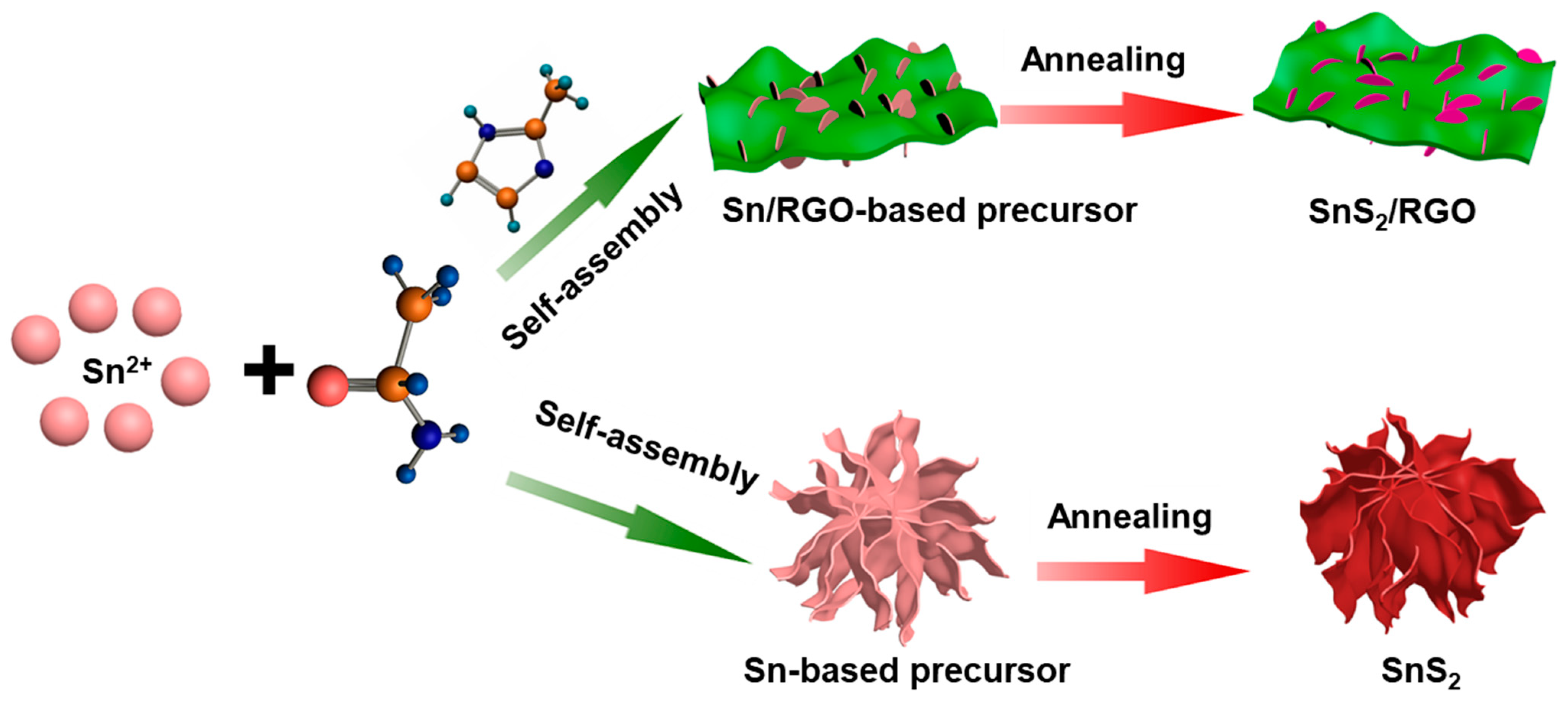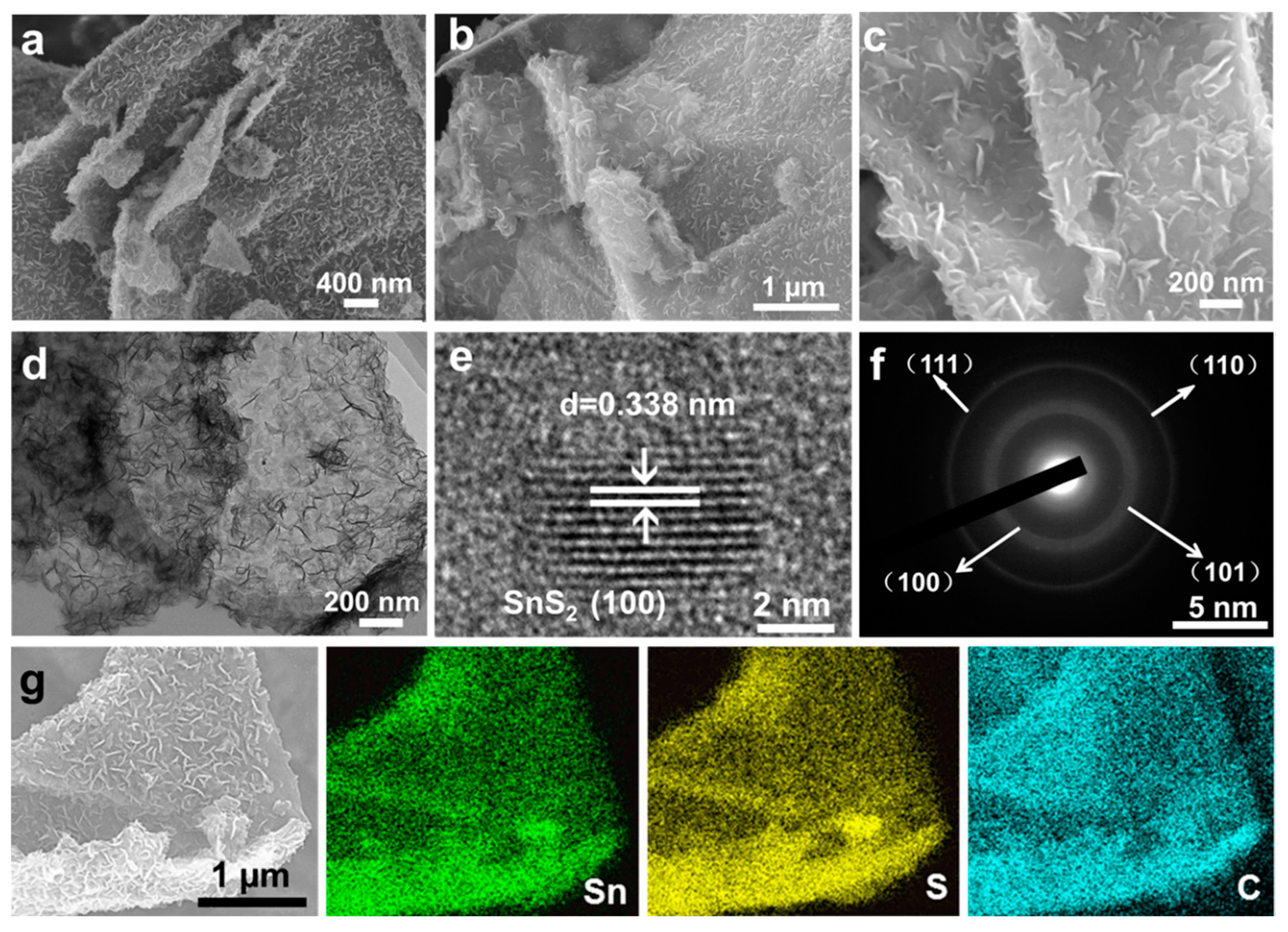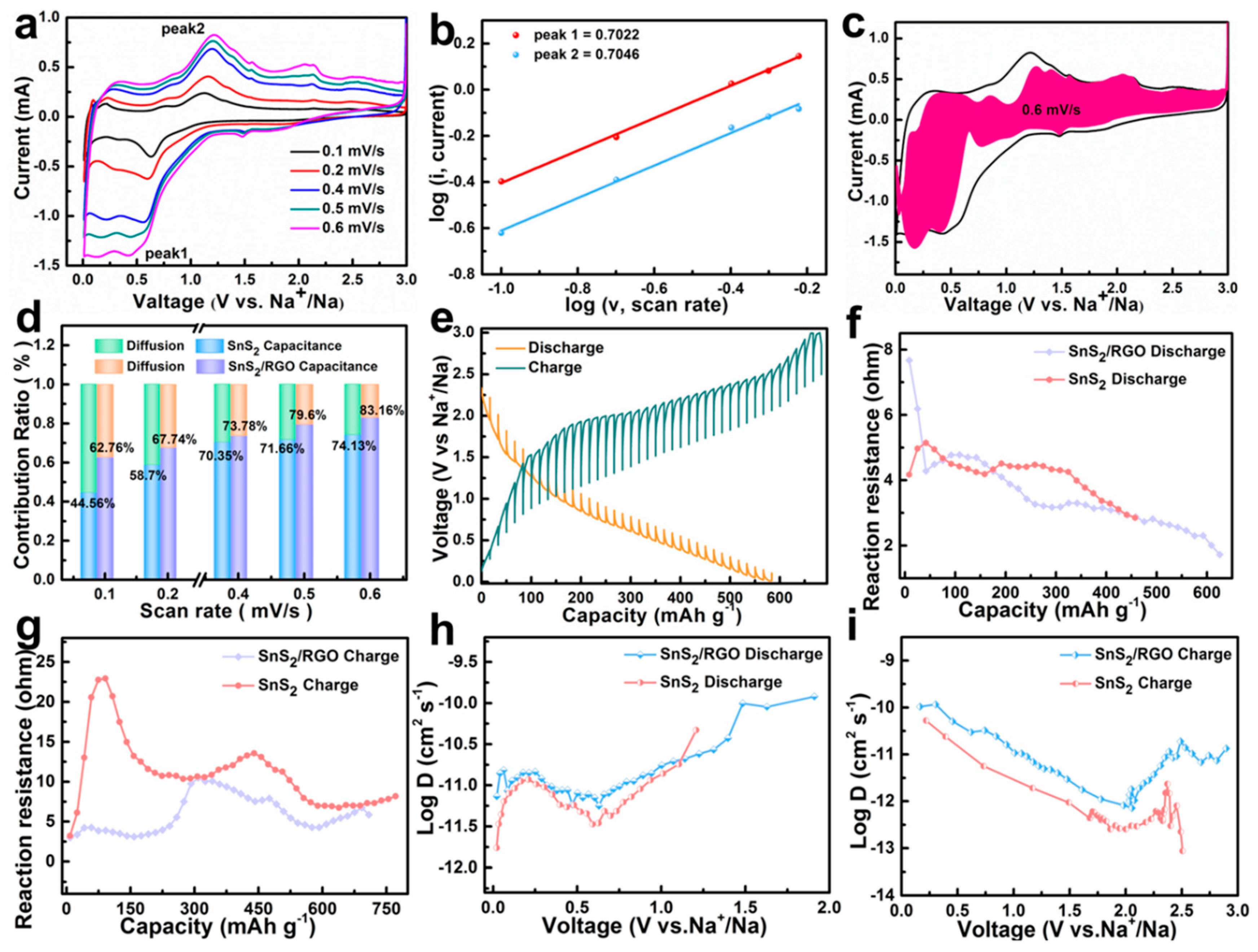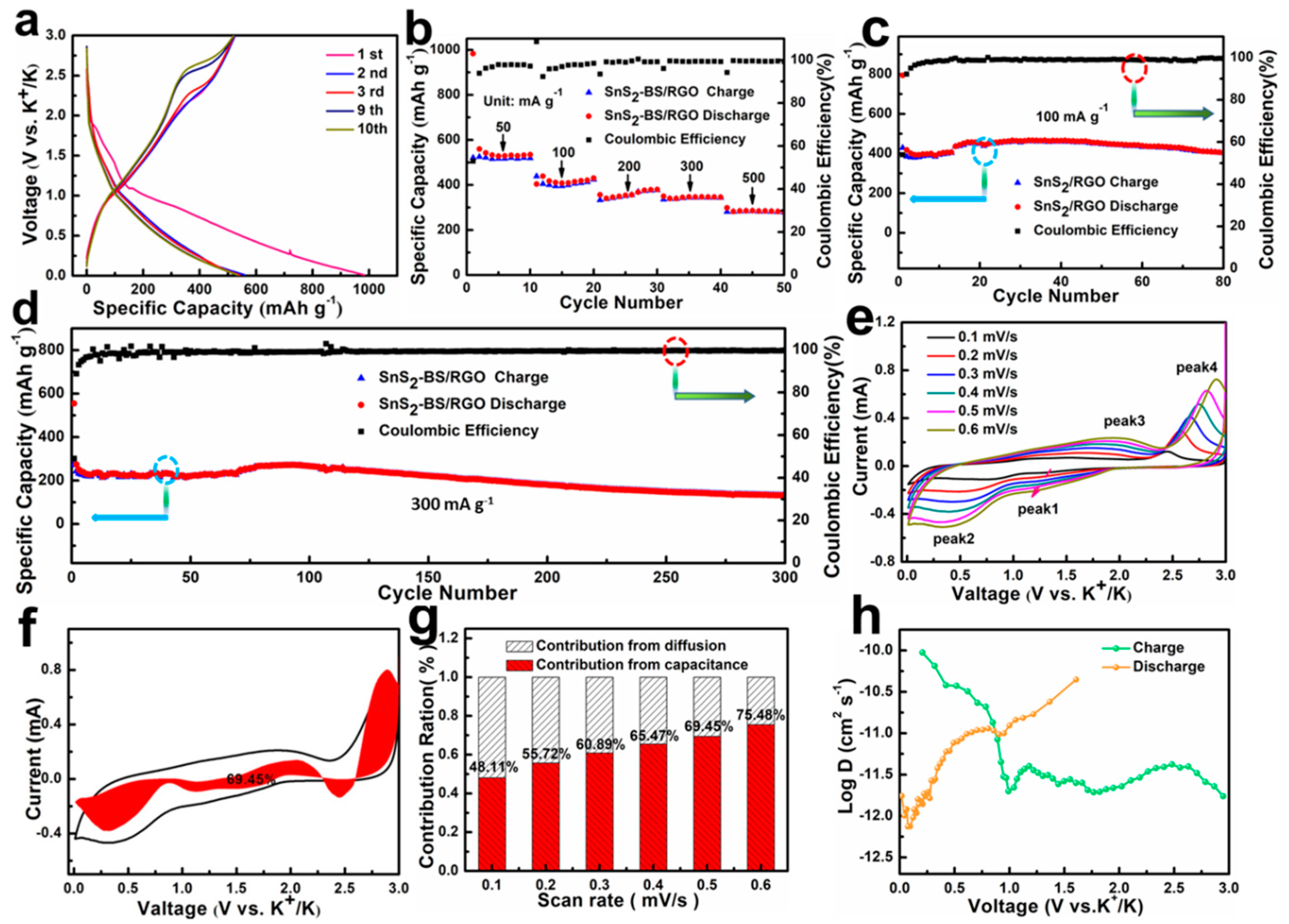SnS2 Nanosheets with RGO Modification as High-Performance Anode Materials for Na-Ion and K-Ion Batteries
Abstract
:1. Introduction
2. Materials and Methods
2.1. Synthesis of SnS2, and SnS2/RGO Nanoarrays
2.2. Materials Characterization
2.3. Electrochemical Measurements
3. Results and Discussion
4. Conclusions
Supplementary Materials
Author Contributions
Funding
Conflicts of Interest
References
- Hamza, D.; Maziar, A.; Dana, A.; Zheng, Y.; Kamil, K.; Carlo, U.S.; Braja, K.M. MnO2-Coated Dual Core-Shell Spindle-Like Nanorods for Improved Capacity Retention of Lithium-Sulfur Batteries. ChemEngineering 2020, 4, 42. [Google Scholar]
- Zheng, Y.; Hamza, D.; Maziar, A.; Kamil, K.; Shankar, A.; Stoichko, A.; Bader, A.; Carlo, U.S.; Braja, K.M. Synthesis of a Very High Specific Surface Area Active Carbon and Its Electrical Double-Layer Capacitor Properties in Organic Electrolytes. ChemEngineering 2020, 4, 43. [Google Scholar]
- Yang, C.; Lv, F.; Dong, K.; Lai, F.; Zhao, K.; Sun, F.; Dou, S.; Wang, Q.; Xu, J.; Zhang, P.; et al. Carbon-Coated Ultrathin Metallic V5Se8 Nanosheet for High-Energy-Density and Robust Potassium Storage. Energy Storage Mater. 2021, 35, 1–11. [Google Scholar] [CrossRef]
- Li, W.; Wang, D.; Gong, Z.; Yin, Z.; Guo, X.; Liu, J.; Mao, C.; Zhang, Z.; Li, G. A Robust Strategy for Engineering Fe7S8/C Hybrid Nanocages Reinforced by Defect-Rich MoS2 Nanosheets for Superior Potassium-Ion Storage. ACS Nano 2020, 14, 16046–16056. [Google Scholar] [CrossRef] [PubMed]
- Dong, C.; Liang, J.; He, Y.; Li, C.; Chen, X.; Guo, L.; Tian, F.; Qian, Y.; Xu, L. NiS1.03 Hollow Spheres and Cages as Superhigh Rate Capacity and Stable Anode Materials for Half/Full Sodium-Ion Batteries. ACS Nano 2018, 12, 8277–8287. [Google Scholar] [CrossRef]
- Roy, K.; Li, T.; Ogale, S.; Robertson, N. Hybrid Perovskite-Like Iodobismuthates as Low-Cost and Stable Anode Materials for Lithium-Ion Battery Applications. J. Mater. Chem. A 2021, 9, 2689–2693. [Google Scholar] [CrossRef]
- Zhang, Y.; Xie, M.; He, Y.; Zhang, Y.; Liu, L.; Hao, T.; Ma, Y.; Shi, Y.; Sun, Z.; Liu, N.; et al. Hybrid NiO/Co3O4 Nanoflowers as High-Performance Anode Materials for Lithium-Ion Batteries. Chem. Eng. J. 2021, 420, 130469. [Google Scholar] [CrossRef]
- Shi, N.; Xi, B.; Huang, M.; Ma, X.; Li, H.; Feng, J.; Xiong, S. Hierarchical Octahedra Constructed by Cu2S/MoS2⊂Carbon Framework with Enhanced Sodium Storage. Small 2020, 16, 2000952. [Google Scholar] [CrossRef]
- Zeng, T.B.; Chen, G.; Peng, Q.M.; Feng, D.; Wang, Q. Nano Sn2S3 Embedded in Nitrogenous-Carbon Compounds for Long-Life and High-Rate Cycling Sodium-Ion Batteries. ChemSusChem 2021, 14, 2383–2392. [Google Scholar] [CrossRef]
- Ding, J.; Tang, C.; Zhu, G.; Sun, W.; Du, A.; He, F.; Wu, M.; Zhang, H. Integrating SnS2 Quantum Dots with Nitrogen-Doped Ti3C2Tx MXene Nanosheets for Robust Sodium Storage Performance. ACS Appl. Energy Mater. 2021, 4, 846–854. [Google Scholar] [CrossRef]
- Xiao, S.; Li, Z.; Liu, J.; Song, Y.; Li, T.; Xiang, Y.; Chen, J.S.; Yan, Q. Se-C Bonding Promoting Fast and Durable Na+ Storage in Yolk-Shell SnSe2@Se-C. Small 2020, 16, 2002486. [Google Scholar] [CrossRef] [PubMed]
- Dong, C.F.; Guo, L.J.; He, Y.Y.; Chen, C.J.; Qian, Y.T.; Chen, Y.N.; Xu, L.Q. Sandwich-Like Ni2P Nanoarray/Nitrogen-Doped Graphene Nanoarchitecture as a High-Performance Anode for Sodium and Lithium Ion Batteries. Energy Storage Mater. 2018, 15, 234–241. [Google Scholar] [CrossRef] [Green Version]
- Li, D.; Dai, L.; Ren, X.; Ji, F.; Sun, Q.; Zhang, Y.; Ci, L. Foldable Potassium-Ion Batteries Enabled by Free-Standing and Flexible SnS2@C Nanofibers. Energy Environ. Sci. 2021, 14, 424–436. [Google Scholar] [CrossRef]
- Li, Y.F.; Wang, S.G.; Shi, Y.H.; Fan, C.Y.; Lin, J.; Wu, X.L.; Sun, H.Z.; Zhang, J.P.; Xie, H.M. In Situ Chemistry-Encapsulated Controlled SnS2 Nanocrystal Composites for Durable Lithium/Sodium-Ion Batteries. Dalton Trans. 2020, 49, 15874–15882. [Google Scholar] [CrossRef]
- Chen, G.; Li, X.; Zeng, T.; Han, R.; Wang, Q. Carbon-Coated Sn2S3 Hollow Spheres as High Performance Anode Materials for Sodium-Ion Batteries. Carbon 2021, 171, 464–473. [Google Scholar] [CrossRef]
- Sun, Q.; Li, D.; Dai, L.; Liang, Z.; Ci, L. Structural Engineering of SnS2 Encapsulated in Carbon Nanoboxes for High-Performance Sodium/Potassium-Ion Batteries Anodes. Small 2020, 16, e2005023. [Google Scholar] [CrossRef]
- Zhao, B.; Song, D.; Ding, Y.; Li, W.; Wang, Z.; Jiang, Y.; Zhang, J. Size-Tunable SnS2 Nanoparticles Assembled on Graphene as Anodes for High Performance Lithium/Sodium-Ion Batteries. Electrochim. Acta 2020, 354, 136730. [Google Scholar] [CrossRef]
- Zhu, L.; Yang, X.X.; Xiang, Y.-H.; Kong, P.; Wu, X.W. Neurons-System-Like Structured SnS2/CNTs Composite for High-Performance Sodium-Ion Battery anode. Rare Met. 2021, 40, 1383–1390. [Google Scholar] [CrossRef]
- Wang, Y.; Zhou, J.; Wu, J.; Chen, F.; Li, P.; Han, N.; Huang, W.; Liu, Y.; Ye, H.; Zhao, F.; et al. Engineering SnS2 Nanosheet Assemblies for Enhanced Electrochemical Lithium and Sodium Ion Storage. J. Mater. Chem. A 2017, 5, 25618–25624. [Google Scholar] [CrossRef]
- Lakshmi, V.; Chen, Y.; Mikhaylov, A.A.; Medvedev, A.G.; Sultana, I.; Rahman, M.; Lev, O.; Prikhodchenko, P.V.; Glushenkov, A.M. Nanocrystalline SnS2 Coated onto Reduced Graphene Oxide: Demonstrating the Feasibility of a Non-Graphitic Anode with sulfide chemistry for potassium-ion batteries. Chem. Commun. 2017, 53, 8272–8275. [Google Scholar] [CrossRef] [Green Version]
- Yao, L.B.; Nie, M.; Zhu, C.Y.; Cai, R.; Xia, W.W.; Sun, L.T.; Xu, F. Revealing a Conversion-Alloying Reaction Mechanism Behind High Capacity and Rate Capability of SnS/N-Doped Graphene Anode by in Situ TEM. Electrochim. Acta 2019, 297, 46–54. [Google Scholar] [CrossRef]
- Liu, Y.C.; Kang, H.Y.; Jiao, L.F.; Chen, C.C.; Cao, K.Z.; Wang, Y.J.; Yuan, H.T. Exfoliated-SnS2 Restacked on Graphene as a High-Capacity, High-Rate, and Long-Cycle Life Anode for Sodium Ion Batteries. Nanoscale 2015, 7, 1325–1332. [Google Scholar] [CrossRef]
- Li, S.; Zhao, Z.; Li, C.; Liu, Z.; Li, D. SnS2@C Hollow Nanospheres with Robust Structural Stability as High-Performance Anodes for Sodium Ion Batteries. Nano-Micro Lett. 2019, 11, 14. [Google Scholar] [CrossRef] [PubMed]
- Sang, Z.; Yan, X.; Su, D.; Ji, H.; Wang, S.; Dou, S.X.; Liang, J. A Flexible Film with SnS2 Nanoparticles Chemically Anchored on 3D-Graphene Framework for High Areal Density and High Rate Sodium Storage. Small 2020, 16, 2001265. [Google Scholar] [CrossRef] [PubMed]
- Guan, S.; Wang, T.; Fu, X.; Fan, L.-Z.; Peng, Z. Coherent SnS2/NiS2 Hetero-Nanosheet Arrays with Fast Charge Transfer for Enhanced Sodium-Ion Storage. Appl. Surf. Sci. 2020, 508, 145241. [Google Scholar] [CrossRef]
- Zhang, S.W.; Lv, W.; Qiu, D.; Cao, T.F.; Zhang, J.; Lin, Q.W.; Chen, X.R.; He, Y.B.; Kang, F.Y.; Yang, Q.H. An Ion-Conducting SnS-SnS2 Hybrid Coating for Commercial Activated Carbons Enabling Their Use as High Performance Anodes for Sodium-Ion Batteries. J. Mater. Chem. A 2019, 7, 10761–10768. [Google Scholar] [CrossRef]
- Cheng, L.; Zhang, Y.; Chu, P.; Wang, S.; Li, Y.; Ren, X.; Zhang, P.; Sun, L. Heterostructure Enhanced Sodium Storage Performance for SnS2 in Hierarchical SnS2/Co3S4 Nanosheet Array Composite. J. Mater. Chem. A 2021, 9, 1630–1642. [Google Scholar] [CrossRef]
- Dong, C.F.; Guo, L.J.; Li, H.B.; Zhang, B.; Gao, X.; Tian, F.; Qian, Y.T.; Wang, D.B.; Xu, L.Q. Rational Fabrication of CoS2/Co4S3@N-Doped Carbon Microspheres as Excellent Cycling Performance Anode for Half/Full Sodium Ion Batteries. Energy Storage Mater 2020, 25, 679–686. [Google Scholar] [CrossRef]
- Zhang, Y.P.; Shen, Y.H.; Xie, X.B.; Du, W.; Kang, L.T.; Wang, Y.; Sun, X.Q.; Li, Z.H.; Wang, B. One-Step Synthesis of the Reduced Graphene Oxide@NiO Composites for Supercapacitor Electrodes by Electrode-Assisted Plasma Electrolysis. Mater. Des. 2020, 196, 109111. [Google Scholar] [CrossRef]
- Zhou, Y.; Zhang, M.; Han, Q.; Liu, Y.; Wang, Y.; Sun, X.; Zhang, X.; Dong, C.; Jiang, F. Hierarchical 1T-MoS2/MoOx@NC Microspheres as Advanced Anode Materials for Potassium/Sodium-Ion Batteries. Chem. Eng. J. 2021, 428, 131113. [Google Scholar] [CrossRef]
- Wang, S.J.; Liu, S.S.; Li, X.M.; Li, C.; Zang, R.; Man, Z.M.; Wu, Y.H.; Li, P.X.; Wang, G.X. SnS2/Sb2S3 Heterostructures Anchored on Reduced Grapheme Oxide Nanosheets with Superior Rate Capability for Sodium-Ion Batteries. Chem. Eur. J. 2018, 24, 3873–3881. [Google Scholar] [CrossRef]
- He, Y.; Dong, C.; He, S.; Li, H.; Sun, X.; Cheng, Y.; Zhou, G.; Xu, L. Bimetallic Nickel Cobalt Sulfides with Hierarchical Coralliform Architecture for Ultrafast and Stable Na-Ion Storage. Nano Res. 2021, 1–11. [Google Scholar] [CrossRef]
- Wang, X.; Xi, B.J.; Ma, X.J.; Feng, Z.Y.; Jia, Y.X.; Feng, J.K.; Qian, Y.T.; Xiong, S.L. Boosting Zinc-Ion Storage Capability by Effectively Suppressing Vanadium Dissolution Dased on Robust Layered Barium Vanadate. Nano Lett. 2020, 20, 2899–2906. [Google Scholar] [CrossRef]
- Dong, C.F.; Wu, L.Q.; He, Y.Y.; Zhou, Y.L.; Sun, X.P.; Du, W.; Sun, X.Q.; Xu, L.Q.; Jiang, F.Y. Willow-Leaf-Like ZnSe@N-Doped Carbon Nanoarchitecture as a Stable and High-Performance Anode Material for Sodium-Ion and Potassium-Ion Batteries. Small 2020, 16, 2004580. [Google Scholar] [CrossRef]
- Wu, F.; Gao, X.; Xu, X.; Jiang, Y.; Gao, X.; Yin, R.; Shi, W.; Liu, W.; Lu, G.; Cao, X. MnO2 Nanosheet-Assembled Hollow Polyhedron Grown on Carbon Cloth for Flexible Aqueous Zinc-Ion Batteries. ChemSusChem 2020, 13, 1537–1545. [Google Scholar] [CrossRef]
- Guo, Q.; Shao, H.; Zhang, K.; Chen, G.; Kong, W.; Feng, X.; Gao, Y.; Liu, Y.; Wang, N.; Dong, C.; et al. CoP Nanoparticles Intertwined with Graphene Nanosheets as a Superior Anode for Half/Full Sodium-Ion Batteries. ChemElectroChem 2021, 8, 2022–2027. [Google Scholar] [CrossRef]
- Cao, L.; Gao, X.; Zhang, B.; Ou, X.; Zhang, J.; Luo, W.-B. Bimetallic Sulfide Sb2S3@FeS2 Hollow Nanorods as High-Performance Anode Materials for Sodium-Ion Batteries. ACS Nano 2020, 14, 3610–3620. [Google Scholar] [CrossRef]
- Dong, C.; Zhou, Y.; Liu, W.; Du, W.; Zhang, X.; Sun, X.; Kang, L.; Zhang, X.; Jiang, F. Zn-Ce based Bimetallic Organic Frameworks Derived ZnSe/CeO2 Nanoparticles Encapsulated by Reduced Graphene Oxide for Enhanced Sodium-Ion and Lithium-Ion Storage. J. Alloy. Compd. 2021, 875, 159903. [Google Scholar] [CrossRef]
- Liu, X.; Hao, Y.; Shu, J.; Sari, H.M.K.; Lin, L.; Kou, H.; Li, J.; Liu, W.; Yan, B.; Li, D.; et al. Nitrogen/Sulfur Dual-Doping of Reduced Graphene Oxide Harvesting Hollow ZnSnS3 Nano-Microcubes with Superior Sodium Storage. Nano Energy 2019, 57, 414–423. [Google Scholar] [CrossRef]
- Zhao, Y.; Zhu, J.; Ong, S.J.H.; Yao, Q.; Shi, X.; Hou, K.; Xu, Z.J.; Guan, L. High-Rate and Ultralong Cycle-Life Potassium Ion Batteries Enabled by In Situ Engineering of Yolk-Shell FeS2@C Structure on Graphene Matrix. Adv. Energy Mater. 2018, 8, 1802565. [Google Scholar] [CrossRef]






Publisher’s Note: MDPI stays neutral with regard to jurisdictional claims in published maps and institutional affiliations. |
© 2021 by the authors. Licensee MDPI, Basel, Switzerland. This article is an open access article distributed under the terms and conditions of the Creative Commons Attribution (CC BY) license (https://creativecommons.org/licenses/by/4.0/).
Share and Cite
Wu, L.; Shao, H.; Yang, C.; Feng, X.; Han, L.; Zhou, Y.; Du, W.; Sun, X.; Xu, Z.; Zhang, X.; et al. SnS2 Nanosheets with RGO Modification as High-Performance Anode Materials for Na-Ion and K-Ion Batteries. Nanomaterials 2021, 11, 1932. https://doi.org/10.3390/nano11081932
Wu L, Shao H, Yang C, Feng X, Han L, Zhou Y, Du W, Sun X, Xu Z, Zhang X, et al. SnS2 Nanosheets with RGO Modification as High-Performance Anode Materials for Na-Ion and K-Ion Batteries. Nanomaterials. 2021; 11(8):1932. https://doi.org/10.3390/nano11081932
Chicago/Turabian StyleWu, Leqiang, Hengjia Shao, Chen Yang, Xiangmin Feng, Linxuan Han, Yanli Zhou, Wei Du, Xueqin Sun, Zhijun Xu, Xiaoyu Zhang, and et al. 2021. "SnS2 Nanosheets with RGO Modification as High-Performance Anode Materials for Na-Ion and K-Ion Batteries" Nanomaterials 11, no. 8: 1932. https://doi.org/10.3390/nano11081932





